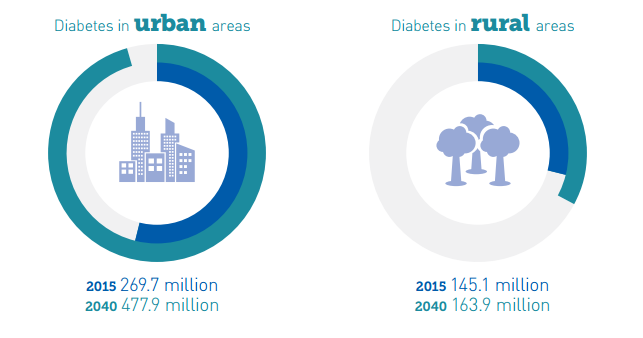How 5 cities are working to wipe out diabetes
[Image: REUTERS/Mario Anzuoni]
By 2050, two thirds of the world’s population will be city dwellers, the result of a trend towards rapid urbanisation that presents both new opportunities and challenges.
On the one hand, people are drawn to the social and economic possibilities of an urban life, which also brings them closer to health services. On the other hand, certain aspects of city lifestyles are contributing to new and fast-moving public health challenges on an unprecedented scale. Over the next 25 years, the number of people with diabetes will be upwards of half a billion. Three in four of these people will call a city home.
In 2014, recognising the importance of healthy, liveable cities, Novo Nordisk partnered with University College London (UCL) and Steno Diabetes Centre on the Cities Changing Diabetes programme.
The partnership aims to put urban diabetes at the top of the global healthcare agenda, and firmly in the consciousness of those designing and managing the cities of the future. We are working to provide a credible, international understanding of the problem and in turn provide a blueprint for actions that improve individual and public health.
Research led by UCL has already begun to shed light on the challenge and helps us understand what makes city dwellers vulnerable to diabetes. Findings from partner cities Mexico City, Houston, Shanghai, Tianjin and Copenhagen show, for the first time, the significant role played by social and cultural factors in diabetes risk factors.
The factors identified include time pressure, financial constraints, cultural food traditions and shifting perceptions of normal body size. Although they may manifest themselves differently, social and cultural factors are shared by cities around the world and therefore provide a basis for diabetes prevention and management strategies.
If anyone is best placed and motivated to take on board these lessons and rise to the challenge, it is the mayors of some of the world’s largest cities. They are closer to their citizens; they have a clear incentive in ensuring that their cities become more liveable and that their citizens are given the best opportunities to remain healthy and productive. Already we are seeing city leaders responding to the research findings and taking action.
In Copenhagen, research identified hard-to-reach populations at high risk within specific districts of the city. Recognising that reaching these individuals requires a multi-sector response, the municipality has announced plans for a Copenhagen city diabetes specialist centre. The unit will provide a point of care for vulnerable individuals and will draw upon health, employment, housing and peer support resources.
In Houston, the research shattered the myth that disadvantage and diabetes vulnerability go hand-in-hand. A sizeable population of upper-middle class citizens that have never been the target of public health policies were found to be at risk. To address this and other challenges, an alliance of 70+ community and faith-based organisations, healthcare providers and employers have come together to redesign public health policies in Houston along five dimensions:
- Enhance awareness and education to improve diabetes understanding.
- Improve navigation for patients to better use prevention, detection, care and management resources.
- Improve collaboration by providers, insurers and employers to improve patient trust.
- Help people prioritise personal health over other life demands.
- Improve the connections between people at risk of diabetes, with diabetes and caregivers and their community.
In 2016, the movement will grow, as Johannesburg and Vancouver join the programme and start work to better prevent and manage diabetes among their own populations. Whether other cities are part of the programme or simply wish to independently tackle urban diabetes, three clear principles can help them to succeed:
- Create new models for collaboration. This means forging new partnerships that engage all sectors and levels of the community: local government, businesses, schools, non-profits, healthcare providers, grassroots organisations and individuals. This is critical to create policy change that promotes community-wide health and well-being.
- Form peer-to-peer community networks. Since the people most vulnerable to diabetes are often barely reached by the formal healthcare system, we must look beyond it. Peer-to-peer networks can play an important role in changing people’s ability to manage their own health and equipping them to live with diabetes.
- Make health a priority in urban planning. When cities are planned, managed and governed well, they can be engines of prosperity and greater personal well-being. But when this isn’t the case, inequalities, working patterns, lifestyles and cultural norms that cities foster can magnify vulnerabilities to diabetes and other chronic conditions. So leaders in health need to work more closely with those who design and manage cities to ensure urban spaces are thoughtfully optimised for their citizens’ health.
Cities are undoubtedly on the frontline in the fight against global diabetes and it is encouraging to see the emergence of a movement against the condition in the urban setting. Addressing this global challenge will require broader mapping of urban diabetes; continued sharing of lessons learned and collaborative local action. The road to changing diabetes will be a long one, but we will get there – one city at a time.
This article was written by Niels Lund, Vice President, Changing Diabetes, Novo Nordisk
This article was also published on the Future of Construction Knowledge Sharing Platform and the WEF Agenda Blog.
--Future of Construction 16:26, 16 Jun 2017 (BST)
[edit] Find out more
[edit] Related articles on Designing Buildings Wiki
Featured articles and news
RTPI leader to become new CIOB Chief Executive Officer
Dr Victoria Hills MRTPI, FICE to take over after Caroline Gumble’s departure.
Social and affordable housing, a long term plan for delivery
The “Delivering a Decade of Renewal for Social and Affordable Housing” strategy sets out future path.
A change to adoptive architecture
Effects of global weather warming on architectural detailing, material choice and human interaction.
The proposed publicly owned and backed subsidiary of Homes England, to facilitate new homes.
How big is the problem and what can we do to mitigate the effects?
Overheating guidance and tools for building designers
A number of cool guides to help with the heat.
The UK's Modern Industrial Strategy: A 10 year plan
Previous consultation criticism, current key elements and general support with some persisting reservations.
Building Safety Regulator reforms
New roles, new staff and a new fast track service pave the way for a single construction regulator.
Architectural Technologist CPDs and Communications
CIAT CPD… and how you can do it!
Cooling centres and cool spaces
Managing extreme heat in cities by directing the public to places for heat stress relief and water sources.
Winter gardens: A brief history and warm variations
Extending the season with glass in different forms and terms.
Restoring Great Yarmouth's Winter Gardens
Transforming one of the least sustainable constructions imaginable.
Construction Skills Mission Board launch sector drive
Newly formed government and industry collaboration set strategy for recruiting an additional 100,000 construction workers a year.
New Architects Code comes into effect in September 2025
ARB Architects Code of Conduct and Practice available with ongoing consultation regarding guidance.
Welsh Skills Body (Medr) launches ambitious plan
The new skills body brings together funding and regulation of tertiary education and research for the devolved nation.
Paul Gandy FCIOB announced as next CIOB President
Former Tilbury Douglas CEO takes helm.
UK Infrastructure: A 10 Year Strategy. In brief with reactions
With the National Infrastructure and Service Transformation Authority (NISTA).

























